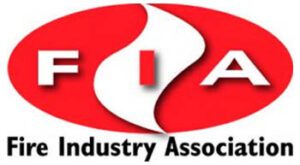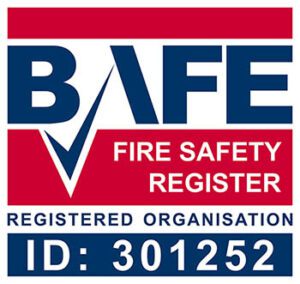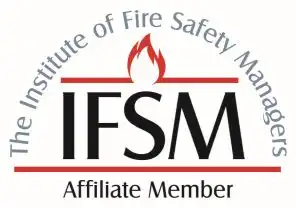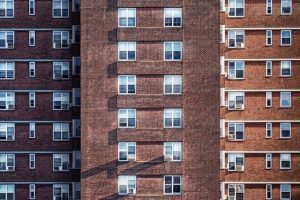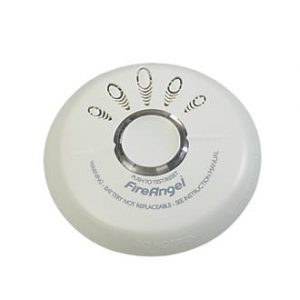Adequate fire safety in tower blocks and purpose-built flats is vital, to protect the lives and homes of residents.
As seen with the awful fire which raged through Grenfell Tower in North Kensington in London in 2017, fires in tower blocks can be devastating, even resulting in loss of life.
To help residents, managing agents and landlords, we have pulled together a simple guide to fire safety in tower blocks, with the aim of keeping occupants safe and preventing another such tragedy.
If, after reading this article, you have any questions, please call our expert team on 0800 157 1113. They will be happy to help and will give free advice over the phone if they possibly can.
Summary of key fire safety measures needed in tower blocks
We cover some commonly asked questions regarding fire safety in tower blocks in detail below, but firstly here are the 7 main fire safety measures you should take in tower blocks and purpose-built flats.
1. Have a Fire Risk Assessment – your tower block should have a valid Fire Risk Assessment, reviewed within the last 12 months, and any recommendations should have been carried out.
2. Communicate policies and procedures – the person responsible for fire safety in the tower block (the ‘Responsible Person’) should communicate fire safety policies and procedures to the residents, preferably annually. They should also make sure these are communicated via ‘Fire Action Notices’ in the common areas of the building.
3. Have correct compartmentalisation – your tower block should be sub-divided into ‘compartments’ – e.g. rooms and corridors – to prevent the rapid spread of fire and allow for escape, in accordance with current building regulations.
4. Clear escape routes – means of escape, such as corridors and stairwells, should be kept free from flammable materials like cardboard boxes, and sources of ignition, like gas canisters.
5. Have suitable fire doors – flat front doors should be fire doors of a suitable standard. Fire doors in common areas, such as corridors, must also be of the right standard, and kept closed at all times. They should be clearly labelled with ‘Fire door, keep shut’ signs.
6. Fit smoke detection – all flats should be fitted with domestic smoke detectors, at least in the escape route – i.e. the corridor leading to the front door – and ideally in every room.
7. Maintain dry risers if you have them – tower blocks over a certain height are fitted with ‘dry risers’. These are empty pipes that the fire brigade uses to pump water to multiple levels in the event of the fire, and must be serviced regularly.
You can read our simple guide to current UK fire safety legislation.
FAQs
1. Who is responsible for fire safety in tower blocks?
The responsibility for fire safety in tower blocks and purpose-built flats is usually divided between the residents, and the landlord or managing agent.
Residents
Residents (i.e. tenants and leaseholders) are responsible for making sure that their flats have appropriate detection, such as smoke detectors, and that they are kept in working order.
If the property is freehold, then the tenant is also responsible for making sure that the flat front door is a fire door of a suitable standard.
If the property is leasehold, then the tenant and the leaseholder are jointly responsible for making sure the flat has an adequate fire door as the front door.
Landlords and Managing Agents
The landlord or managing agent is usually responsible for fire safety in the ‘common areas’ of a tower block or purpose-built block of flats, such as stairwells and corridors.
However, in some tower blocks this responsibility is held by a member of the Residents’ Association.
Whoever it is, they are the designated ‘Responsible Person’ for fire safety in your tower block’s common areas.
This means it is their duty to make sure that there is a valid Fire Risk Assessment for the property, that the common areas are protected from fire, and that residents are aware of the building’s fire safety policies and procedures.
Having a person responsible for fire safety in a building is a legal requirement as set out in the Fire Safety Regulatory Reform Order, or RRO – learn more in our simplified guide to the RRO.
Your building’s designated Responsible Person is the first person you should contact if you want to know more about the fire safety measures, policies, and procedures in your tower block or purpose-built block of flats.
2. I am a tower block resident, what fire detection do I need in my flat?
You need domestic smoke detectors in your flat.
You can buy these from DIY stores or from online retailers, although the Fire Brigade will supply them free of charge to some residents, e.g. if you are older.
We recommend buying a smoke alarm fitted with 10 year lithium batteries, such as the ‘FireAngel’ brand smoke alarms. This means there is far less likelihood of the batteries going flat.
You should at least have smoke detectors in your escape routes – i.e. corridors. Ideally you would have interlinked detectors in every room (or a full wireless fire alarm system), so if one is triggered, they all go off.
3. I am responsible for my flat’s fire door, what do I need to know?
Firstly check that your flat front door meets the current standards for fire doors.
If your block is a little older the doors will have met fire safety standards when the block was built, but may need upgrading to meet current recommendations. This does not mean that they are unsafe.
Fire doors are designed to stop a fire spreading and buy vital time if residents need to escape, so it’s really important that they are of an adequate standard.
What to check:
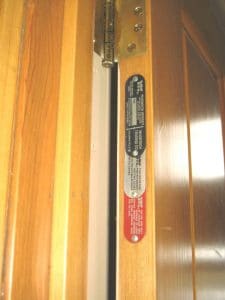
1. Is there a fire door label?
Does your flat front door have a label indicating it is a fire door? This is usually found on the edge nearest the door frame, by the hinge (see our example on the left) (modern doors will have these but older doors may not).
If there’s no label but you live in an older block, you’re door is likely to be a fire door if it is original to the tower block.
However, if a previous resident appears to have changed the door, then it should be checked as it may not be a fire door, but a standard house front door.
2. Is there an effective, automatic door closer?
Flat front doors must be fitted with an effective closer that can close the door fully if you release it at any angle. Overhead closers are the best type for this.
The single chain closers sometimes fitted in the hinge side of the door are not suitable and you should upgrade to an overhead closer if you have these.
This is not necessary for your internal doors, only the one that joins your flat to the common areas.
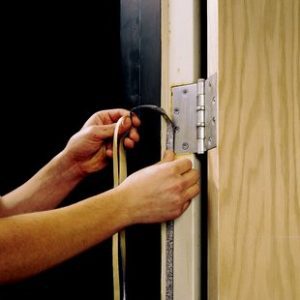
3. Is the door fitted with intumescent strips?
Intumescent strips, or fire seals, expand in the event of a fire and seal off the gap between the door and the frame to prevent the fire and smoke spreading (see image on the left).
Fire doors must be fitted with these to meet current regulations.
4. Does the door fit the frame properly?
The fire door should close fully against the door stops, with no large gaps or other issues that prevent it closing properly.
If you can answer ‘no’ to any of the above questions, then your flat front door will probably need to be upgraded or replaced.
4. I am the Responsible Person for fire safety in a tower block, do I need a fire risk assessment?
If you are responsible for fire safety in a tower block of purpose-built flat, then the first thing you must do is make sure you have a valid Fire Risk Assessment. This is not only a legal requirement, but the cornerstone of all your fire safety plans.
Once you have a fire risk assessment then you must implement any recommendations. These could include making sure escape routes are kept clear, or upgrading fire doors in the common areas.
Your fire risk assessment will tell you exactly what you need to do to be fire safety compliant, which is why it is so important.
5. As a Responsible Person what is my duty to the residents of a tower block?
If you are responsible for fire safety in a tower block, then firstly you must make sure you have a valid fire risk assessment and that all of the recommendations have been carried out. This is the most important way you can protect your residents from fire.
In addition, you should make sure that preventative fire safety measures are being observed – such as regularly making sure that escape routes are clear, or making sure dry risers or other fire-fighting equipment in the building is regularly serviced.
Finally, you should make sure that the tower block’s fire safety policies and procedures are clearly communicated to all residents. You can send these in an email or a letter, and ideally you should send a reminder every year.
You will also need to make sure that Fire Action Notices are displayed in the correct places in the building, informing residents what to do in case of fire.
We hope this guide has been useful to you. You may also find the following article helpful, aimed specifically at choosing between waking watch or a fire alarm system.
If you have any questions at all, or if you’d like to book an appointment with one of our expert Fire Risk Assessors, you can call our friendly team on 0800 157 1113, or email us at [email protected].


